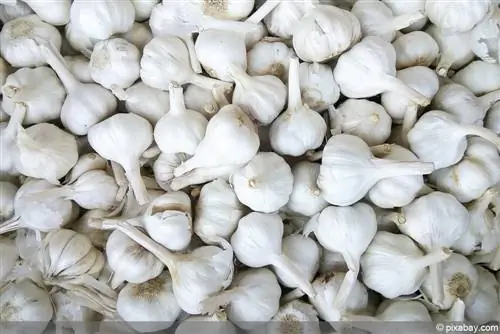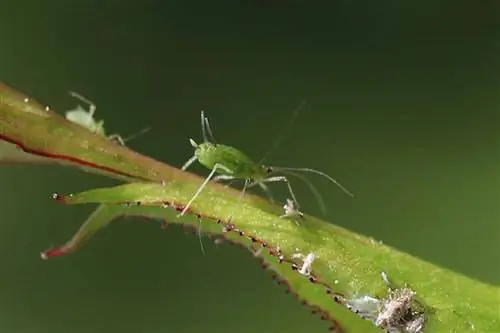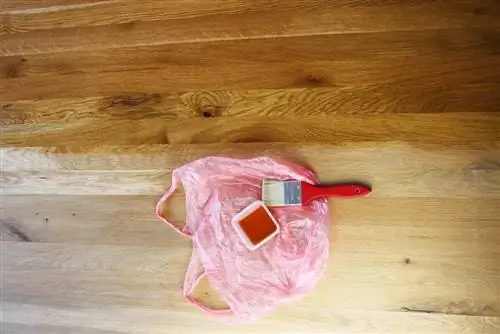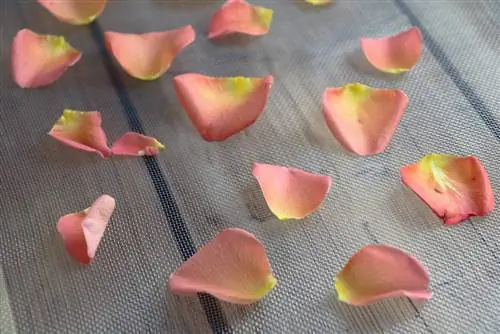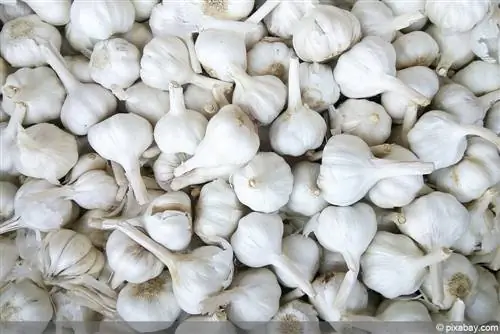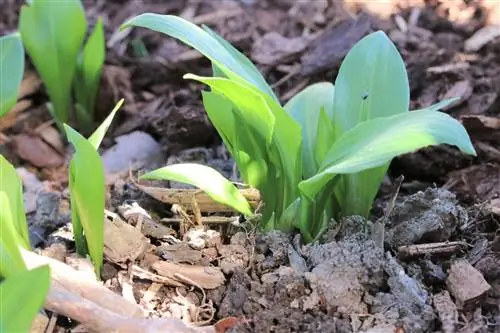- Author admin [email protected].
- Public 2023-12-17 03:39.
- Last modified 2025-01-24 12:45.
The tuber is harvested from early summer to late summer. The harvest time often depends on the weather. Can be harvested before flowers develop. However, if the inflorescences are cut off, the tubers grow particularly well and become significantly larger than usual. If the inflorescences remain, the plant forms flowers and later small bulbs, which can be replanted directly. However, the small onions only produce higher yields over the years.
Harvest garlic
In most cases the harvest occurs towards the end of August. The foliage then turns yellow and begins to wilt. The garlic bulbs are cleared, simply pulled out of the loose soil and roughly brushed off. You shouldn't wait too long before harvesting, because then the tubers will open and fall apart. Although they are still edible, they cannot be stored for long. In addition, they are no longer easy to harvest. The individual toes may have to be pulled out of the ground individually.
Harvest time for the tubers
Garlic can grow for up to two years before being harvested. Garlic planted in the fall is not harvested the following year, but the one after that. However, it can also be harvested earlier. After two years, the garlic bulbs are usually significantly larger, as they have had more time to grow. The taste is then very intense. You can tell when garlic is ready to harvest by looking at the leaves. When about the upper third of the leek has wilted, the tubers can be pulled out of the soil. It is usually enough to grasp the leek stalks tightly with one hand and pull carefully. The bulbs are easy to pull out, similar to onions. If that doesn't work, the spade is a good tool. Alternatively, a handshake is sufficient. At a distance of about 15 cm from the tuber, the spade is pierced into the soil and the soil is carefully raised. The loosened substrate produces the tubers very easily. The tubers, which usually still have soil on them, are air-dried for a day or two and then carefully brushed off. The soil can usually be removed very easily, either by hand, with a brush or with a hand broom.
Dry garlic
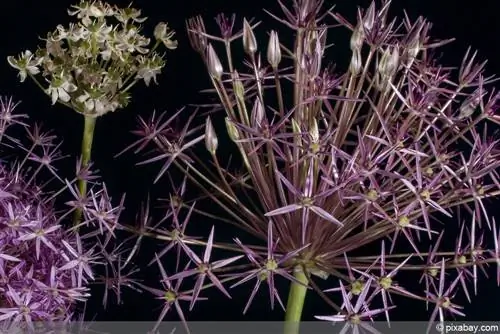
Garlic that is not used fresh can be preserved. There are different types of preservation. Drying is the easiest way. The cleared and cleaned onion is dried in the fresh air. Air drying is the easiest method, but it takes the longest. The advantage is that the aroma is retained and so are the valuable ingredients. So garlic is harvested and air dried for about two days. The tubers are then dried in an airy place, just like onions. Fresh air is important. A dark, well-ventilated room is ideal for drying. Normal room temperature is sufficient. The tubers dry best if the leaves are loosely tied together and the bundles are hung up without the tubers coming into contact with the wall, cupboard or similar. Alternatively, it is possible to place the tubers and their leaves on a wire rack so that air can come in from all sides. Alternatively, a wire basket can be used for this. In many regions, garlic is braided into braids for drying. This works well and looks decorative too. Dried garlic can be used in many ways, as ground garlic powder or garlic granules or as dried garlic slices.
Drying in the dehydrator
The drying process is quicker in the dehydrator, but at the same time it works gently. Finely chopped garlic slices are laid out on the sieve floors of the device and slowly dried using warm air. The ideal mixture of heat and air dries the slices gently so that the aromas and valuable ingredients are retained. The heated air flows out and starts the preservation process. The duration of the process depends on how many slices have been laid out and how thick they are.
Drying in the oven
If you don't have a dehydrator, you can alternatively use the oven to dry. For this type of drying, the tubers are not cut into slices, but halved. But first you peel them. The half cloves are spread out on the oven tray and dried at approx. 70°C top and bottom heat. This takes about 4 hours. If the halves are not yet crisp during this time, they continue to be dried, but only at 65°C. If the garlic feels slightly brittle, it is sufficiently dry.
Store garlic
Garlic should be stored in a dry, cool and dark room with consistent temperature and humidity. Under no circumstances should the room be too humid. If the garlic goes bad, starts to mold or sprouts, it has been stored incorrectly. It is important that it is stored in a dry place, that the room temperature is constant and that garlic is not stored together with fruit.
Tip:
Garlic bulbs should not be stored in the refrigerator because they will lose a lot of their aroma. The same applies to freezing. In principle, freezing is possible, but absolutely not recommended. The aroma is lost, the consistency changes, the taste changes.
Pick garlic in oil
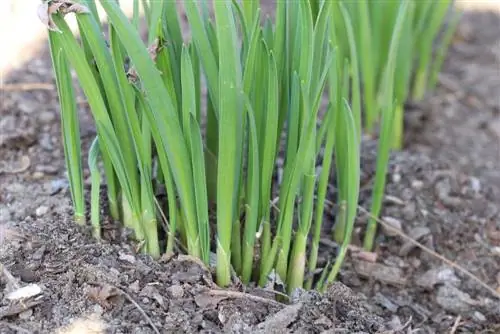
Garlic, preserved in oil, retains its great aroma and has a long shelf life. It doesn't take much effort and is very effective. Approximately 1 liter of olive oil is required for 500 grams of garlic. The tubers are skinned and divided into individual cloves. You put these in one or more tightly sealable containers and pour the olive oil over them. The garlic must be completely covered with oil. The container must be closed tightly. The garlic is often blanched for a few minutes beforehand. You can do that, but you don't have to do it. Additional ingredients ensure variety and a good look. For example, you can add two small chili peppers, 2 sprigs of rosemary or other herbs to the glass. This looks very decorative. Such glasses make nice little gifts and souvenirs.
Garlic pickled with lactic acid
A good way to pickle garlic is to leaven it. This gives it a fine, nutty aroma and loses much of its strong smell. This garlic, pickled in this way, can be used as fresh. It can also be used as a remedy because the metabolism and intestinal flora are stimulated. Very fresh tubers should be used. Cut up about 5 garlic bulbs, peel the cloves and put them in a jar with 1 teaspoon of mustard seeds or preserving spice and a quarter of a bay leaf. Only fill up to about 3 cm below the edge of the glass. Then pour in s alt water (100 ml of boiled, lukewarm s alt water - 15 g of s alt to 1 liter of water). All toes must be completely covered. Close the jar tightly and let everything ferment at room temperature for about 10 days, making sure it is dark. Then it's best to put it in the cool cellar. The garlic can be eaten after about 6 weeks.
Uses of Garlic
Garlic is absolutely versatile. It goes well with many dishes. Some dishes are not possible without the toes, e.g. the Italian spaghetti aglio e olio, garlic bread, gambas al ajillo from Spain, various dips such as aioli and tzatziki and many other dishes.
Tip:
Garlic must not become too brown when frying because it will then have a bitter taste. It is optimal to crush the garlic because this is the best way for it to release its active ingredients and flavors. It should only be cooked briefly and then left to steep.
Conclusion
Garlic goes well with many dishes. Some lovers of these tubers even eat it sliced on toasted bread. However, it doesn't always have to be such a great taste. You can also dose it more delicately. Garlic can not only be used as a spice, but also as a medicine. Many he alth-conscious people swallow garlic capsules every day for their he alth, but there is another way, with garlic from the garden. You can also make these little remedies yourself. You can find plenty of recipes for this on the World Wide Web. Garlic should not be missing in any garden. It is easy to grow and maintain. Harvesting and drying are also very easy. You can do a lot for your own he alth and your palate with the tubers.

